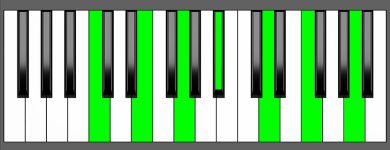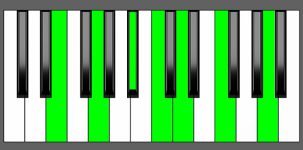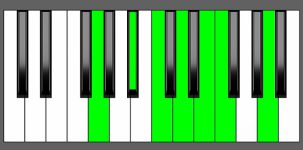Piano Diagram of C13 in Root Position

C13 is a chord that includes the root note C, a major third (E), a perfect fifth (G), a minor seventh (Bb), a major ninth (D), an eleventh (F), and a 13th (A). It’s similar to a 6th chord since the 13th is a 6th at a higher octave but also includes a minor 7th, major 9th, and 11th.
Structure of C13
Notes |
|---|
| C, E, G, Bb, D, F, A |
Intervals |
|---|
| R, 3, 5, m7, 9, 11, 13 |
Playing Extended Chords on Piano
Extended chords are commonly used in piano playing, but they can be tricky to play in their entirety due to the large number of notes involved. To make these chords more manageable, pianists often omit certain notes, such as the root or the 5th. Another technique is to split the chord between both hands, playing either full or partial chords in each hand.
How to play a C13
One approach to playing the C13 chord is by playing the root note C with your left hand then, with your right hand, you can play the minor 7th note Bb, the 9th note D, and the 13th note A. This will result in a simplified C13 chord that only includes the root note, minor 7th, 9th, and 13th notes.
C + Bb, D, A
Alternatively, you can play the root note with your left hand and an inversion of the chord with the 7th note (Bb), the 3rd note (E), and the 13th note (A) with your right hand.
C + Bb, E, A
However, even when notes are omitted or split between hands, extended chords can still create complex and dense harmonies. When these chords are inverted, the resulting clusters of notes can be particularly challenging to voice effectively.
C13 Chord Inversions
The C13 chord has a total of 6 inversions:
| Root Position: | C | E | G | Bb | D | F | A |
| 1st Inversion: | E | G | Bb | C | D | F | A |
| 2nd Inversion: | G | Bb | C | D | E | F | A |
| 3rd Inversion: | Bb | C | D | E | F | G | A |
| 4th Inversion: | D | E | F | G | A | Bb | C |
| 5th Inversion | F | G | A | Bb | C | D | E |
| 6th Inversion | A | Bb | C | D | E | F | G |
Piano Keyboard Diagrams

Chord Inversions on Piano
Understanding chord inversions is an essential aspect of music theory as it helps to explain how chords are arranged. When playing chord inversions on a piano, it’s important to keep in mind that the diagrams used to illustrate the order of notes may not always be practical or even possible to play.
To achieve the proper chord voicings on a piano, you need to distribute the notes of the chord across various octaves and positions on the keyboard. This often means that the basic shape of the chord’s inversions shown in diagrams may not be the most convenient or comfortable way to play the chord.
While chord inversion diagrams can be useful in comprehending the structure and sequence of notes in a chord, it’s always a good idea to try out different voicings and fingerings to discover the most efficient and comfortable way to play the chord, while still maintaining its intended harmonic function and sound.
Music Theory and Harmony of C13
The C13 chord is an extension of the C7 chord and is used on the V and VII degrees of major and natural minor scales, respectively. It can be used in all the positions where C7 can be played, but a more common use is to play it in conjunction with the dominant chord. However, it’s important to note that some positions may not work as well as others when using C13 instead of C7.
If you want to experiment with using C13 as an alternative to C7, you can start by checking out the C7 chord page for ideas on where to begin. Trying out the C13 chord in different positions can help you understand which ones work well and which ones may not be as effective.
Building the C13 Chord: Different Approaches
Starting from the C Major Scale
To form a 13th chord, you combine the root, the major 3rd, the 5th, the minor 7th, the major 9th, the 11th, and the 13th from a major scale.

To create a C13 chord, apply the formula R, 3, 5, m7, 9, 11, 13 in the following way:
- Begin with the Root note, which is C.
- Select the major 3rd interval, E.
- Add the 5th interval, which is G.
- Add the minor 7th interval, Bb.
- Add the major 9th, which is D.
- Add the 11th F, which is a 4th interval at the higher octave.
- Lastly, add the 13th (A), which is a 6th at a higher octave.
By following this simple formula, you can create a 13th chord from any major scale.
by Combining Intervals
One method to create a 13th chord is by combining specific intervals – a major 3rd, a minor 3rd, a minor 3rd, a major 3rd, and a minor 3rd. This is the formula:
3 + m3 + m3 + 3 + m3 + 3 = 13th Chords
Upon analysis of the C13 chord, we can note that:
- the interval between C and E is a major 3rd,
- between E and G is a minor 3rd,
- between G and Bb is a minor 3rd,
- between Bb and D is a major 3rd,
- between D and F there is a minor 3rd,
- and finally, between F and A there is a major 3rd.
by Combining Chords
Another way to build 13th chords is by combining a major triad with a Maj 7th chord derived from its minor 7th, or by merging a dominant 7th chord with a minor triad that is based on its second interval.
C Major + Bb Maj7 = C13
or
C7 + D minor = C13
To build a C13 chord, you can blend a C Major triad with a Bb Major chord or a C7 with a D minor. When played together, these two chords produce a C13 chord.
How to Use C13 in a Chord Progression
The C13 chord is essentially an extension of the C7 chord, with the addition of the 9th (D), the 11th (F), and the 13th (A) note. Because of this, the C13 chord can often be substituted for the C7 chord.
Here are the tables of the major and natural minor scales that include the C dominant 7th chord, which can be substituted or complemented by a C13 chord but I suggest referring to the posts on dominant 7th chords to learn more fancy uses and contexts in which a dominant 13th chord can be played:
on F Major
| Major Scale | I | ii | iii | IV | V | vi | vii |
|---|---|---|---|---|---|---|---|
| F | F Maj7 | G min7 | A min7 | Bb Maj7 | C7 ⇒ C13 | D min7 | Em7b5 |
- Dominant chord in F Major
on D minor
| Natural Minor | i | ii | III | iv | v | VI | VII |
|---|---|---|---|---|---|---|---|
| D | D min7 | Em7b5 | F Maj7 | G min7 | A min7 | Bb Maj7 | C7 ⇒ C13 |
- Leading Tone chord in D minor
C13 Chord Function in Major and Minor Keys
Understanding Scale Degrees
When we form chords from a scale, each note in the scale is given a specific degree that reflects its position within the scale. The degree of a note in a scale determines its function and the role it plays in the overall harmony of the music.
- Starting with the first degree of the scale, we have the Tonic chord. This chord serves as the foundation of the scale, providing a stable tonal center for the music. It’s like the “home base” of the music, and all melodies and harmonies are anchored to this chord.
- Moving on to the second degree, we have the Supertonic. This degree acts as a transitional note between the tonic and other notes in the scale, creating a sense of movement and flow in the melody or harmony.
- The third degree is the Mediant, which is located halfway between the tonic and dominant notes. This degree helps to establish whether the scale is major or minor and plays a critical role in determining the mood and emotional impact of the music.
- The fourth degree is the Subdominant, which complements the dominant and adds tension and resolution to the music. It creates a push-pull effect that keeps the listener engaged and interested.
- The fifth degree is the Dominant, which generates tension and a sense of expectation. It often acts as the climax of a musical phrase or section and is resolved by returning to the tonic.
- The sixth degree is the Submediant, which provides a sense of stability and restfulness to the music. It’s often used as a transition between the dominant and tonic, creating a feeling of calm and relaxation.
- Finally, we have the seventh degree, the Leading tone. This degree produces a strong sense of tension and a desire to resolve to the tonic. It’s often used to create a sense of resolution and completion in the melody or harmony.
C13 as Dominant Chord in F Major
In the context of the F major scale, the C13 chord can serve as the dominant chord on the fifth degree of the scale. This means that C13 would be the fifth chord in the scale and have a strong tendency to resolve to the tonic chord, which is F major in this case, or to the vi chord (D min7), which is the relative minor chord of F major.
| I | ii | iii | IV | V | vi | vii |
| F Maj7 | Gmin7 | A min7 | Bb Maj7 | C7 | D min7 | Em7b5 |
C13 Chord Progressions as V degree
Try playing these chord progressions to get an idea of how C13 functions as the dominant chord. You can choose to modulate towards the C7 chord or play just the C13.
ii V I
| ii | V | I |
| G min7 | C13 | C7
C (Bb, D, A) | C (Bb, E, G) |
F Maj7 |
One possible way to voice the C13 chord is to play the root note C with your left hand and the notes Bb (minor 7th), D (9th), and A (13th) with your right hand. Similarly, for the C7 chord, you can play the root note C with your left hand and the notes Bb, E, and G with your right hand.
I IV V
| I | IV | V |
| F Maj7 | Bb Maj7 | C13 | C7 |
I V vi IV
| I | V | vi | IV |
| F Maj7 | C13 | C7 | D min7 | Bb Maj7 |
I IV vi V
| I | IV | vi | V |
| F Maj7 | Bb Maj7 | D min7 | C13 | C7 |
C13 as the Leading Tone chord in D minor
In the context of the D natural minor scale, the C13 chord can be used as a variation for the dominant 7th chord on the VII degree. Using the C13 chord as a leading tone can create a sense of tension and resolution that can be used to lead into the tonic chord or as part of a modulation to the C7 chord.
| i | ii | III | iv | v | VI | VII |
| D min7 | Em7b5 | F Maj7 | G min7 | A min7 | Bb Maj7 | C7 |
C13 as VII degree – Chord Progressions
Here are some chord progressions that demonstrate how the C13 chord can function as the leading tone or be a part of modulation towards a C7:
i iv VII i
| i | iv | VII | i |
| D min7 | G min7 | C13 | C7 | D min7 |
i VII VI V
| i | VII | VI | v |
| D min7 | C13 | C7 | Bb Maj7 | A min7 |
i III VII VI
| i | III | VII | VI |
| D min7 | F Maj7 | C13 | C7 | Bb Maj7 |
i iv VII VI
| i | iv | VII | VI |
| D min7 | G min7 | C13 | C7 | Bb Maj7 |
i iv VII III
| i | iv | VII | III |
| D min7 | G min7 | C13 | C7 | F Maj7 |
Circle Progression
| i | iv | VII | III | VI | ii | V7 | i |
| D min7 | G min7 | C13 | C7 | F Maj7 | Bb Maj7 | Em7b5 | A7 | D min7 |
Alternative C13 Nomenclature
- C 13
- Do 13
- C 13th
- C 7/13
- C dom13
- C 7/9/11/13
- C Dominant 13
- C Dominant 13th
- C Dominant thirteenth
Conclusion
The chord progressions and examples presented in this post provide a comprehensive overview of the most common uses of the C13 chord. It’s important to note, however, that many advanced harmony-related topics could not be included due to space constraints. These topics include chord progressions built on harmonic and melodic scales, modal scales, hidden tonality, secondary dominants and other chord substitutions, non-functional harmony and atonal music, modal interchange and borrowed chords, voice leading and counterpoint, chromatisms, jazz harmony…I mean, music theory is a huge topic!
Although I couldn’t cover all of these topics in my post, I encourage readers to continue exploring these areas in their study and research. By expanding your knowledge in these advanced areas of music theory, you can gain a deeper understanding of the harmonic possibilities that exist beyond the basics presented here.





